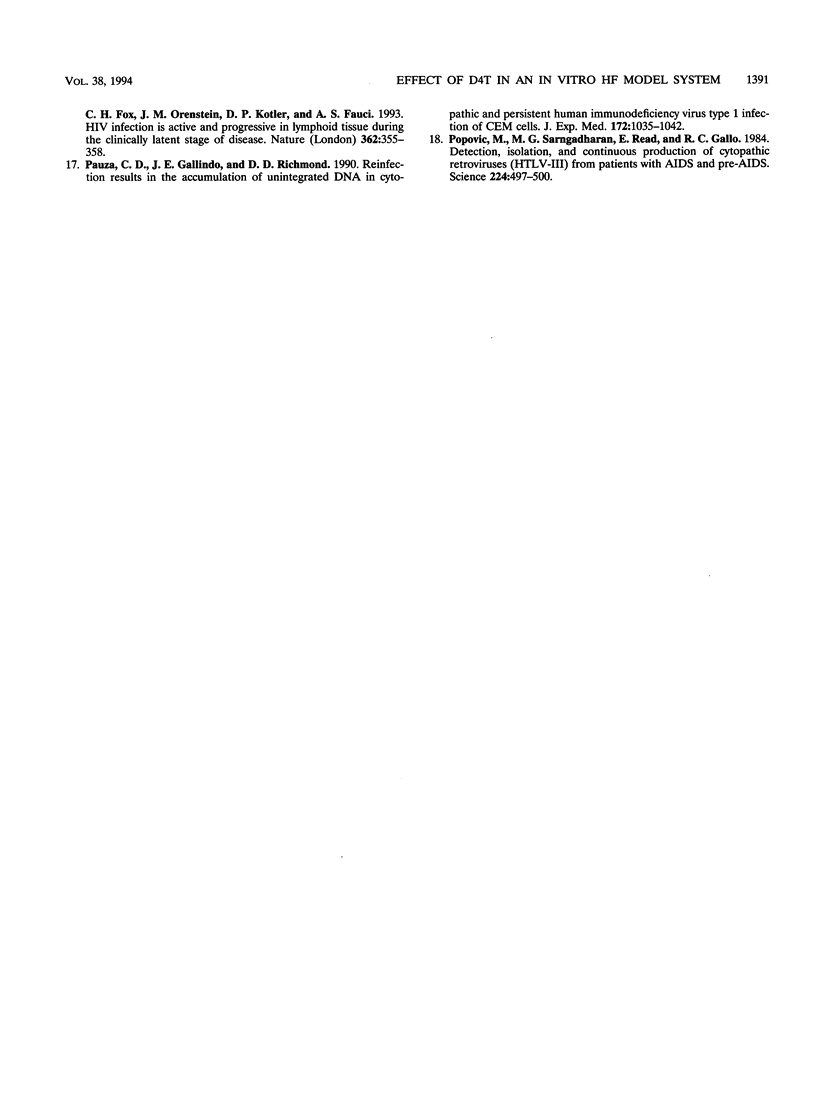Abstract
We sought to validate an in vitro system which could predict the minimal effect dose of antiretroviral agents. Mixtures of uninfected CEM cells and CEM cells chronically infected with human immunodeficiency virus (HIV) type 1 MN were exposed to 2',3'-didehydro-3'-deoxythymidine (D4T) in vitro in a hollow-fiber model which simulates the plasma concentration-time profile of D4T in patients. Drug concentration was adjusted to simulate continuous intravenous infusion, or an intravenous bolus administered twice daily. The effect of the dosing regimen was measured with viral infectivity, p24 antigen, and reverse transcriptase or PCR for unintegrated HIV DNA. Dose deescalation studies on a twice-daily dosing schedule predicted a minimum effect dose of 0.5 mg/kg of body weight per day which correlated with the results of a clinical trial. Antiviral effect was demonstrated to be independent of schedule for every 12-h dosing versus continuous infusion. Finally, at or near the minimal effect dose, efficacy appeared to depend on the viral load. The ability of this in vitro pharmacodynamic model to assess the response of HIV-infected cells to different doses and schedules of antiviral agents may be useful in the design of optimal dosing regimens for clinical trials but requires validation with other types of antiretroviral agents.
Full text
PDF





Selected References
These references are in PubMed. This may not be the complete list of references from this article.
- Blaser J., Stone B. B., Groner M. C., Zinner S. H. Comparative study with enoxacin and netilmicin in a pharmacodynamic model to determine importance of ratio of antibiotic peak concentration to MIC for bactericidal activity and emergence of resistance. Antimicrob Agents Chemother. 1987 Jul;31(7):1054–1060. doi: 10.1128/aac.31.7.1054. [DOI] [PMC free article] [PubMed] [Google Scholar]
- Dickover R. E., Donovan R. M., Goldstein E., Cohen S. H., Bolton V., Huth R. G., Liu G. Z., Carlson J. R. Decreases in unintegrated HIV DNA are associated with antiretroviral therapy in AIDS patients. J Acquir Immune Defic Syndr. 1992;5(1):31–36. [PubMed] [Google Scholar]
- Drusano G. L., Johnson D. E., Rosen M., Standiford H. C. Pharmacodynamics of a fluoroquinolone antimicrobial agent in a neutropenic rat model of Pseudomonas sepsis. Antimicrob Agents Chemother. 1993 Mar;37(3):483–490. doi: 10.1128/aac.37.3.483. [DOI] [PMC free article] [PubMed] [Google Scholar]
- Dudley M. N., Blaser J., Gilbert D., Zinner S. H. Significance of "extravascular" protein binding for antimicrobial pharmacodynamics in an in vitro capillary model of infection. Antimicrob Agents Chemother. 1990 Jan;34(1):98–101. doi: 10.1128/aac.34.1.98. [DOI] [PMC free article] [PubMed] [Google Scholar]
- Dudley M. N., Graham K. K., Kaul S., Geletko S., Dunkle L., Browne M., Mayer K. Pharmacokinetics of stavudine in patients with AIDS or AIDS-related complex. J Infect Dis. 1992 Sep;166(3):480–485. doi: 10.1093/infdis/166.3.480. [DOI] [PubMed] [Google Scholar]
- Forrest A., Nix D. E., Ballow C. H., Goss T. F., Birmingham M. C., Schentag J. J. Pharmacodynamics of intravenous ciprofloxacin in seriously ill patients. Antimicrob Agents Chemother. 1993 May;37(5):1073–1081. doi: 10.1128/aac.37.5.1073. [DOI] [PMC free article] [PubMed] [Google Scholar]
- Hirt B. Selective extraction of polyoma DNA from infected mouse cell cultures. J Mol Biol. 1967 Jun 14;26(2):365–369. doi: 10.1016/0022-2836(67)90307-5. [DOI] [PubMed] [Google Scholar]
- Kim S. Y., Byrn R., Groopman J., Baltimore D. Temporal aspects of DNA and RNA synthesis during human immunodeficiency virus infection: evidence for differential gene expression. J Virol. 1989 Sep;63(9):3708–3713. doi: 10.1128/jvi.63.9.3708-3713.1989. [DOI] [PMC free article] [PubMed] [Google Scholar]
- Knazek R. A., Gullino P. M., Kohler P. O., Dedrick R. L. Cell culture on artificial capillaries: an approach to tissue growth in vitro. Science. 1972 Oct 6;178(4056):65–66. doi: 10.1126/science.178.4056.65. [DOI] [PubMed] [Google Scholar]
- Kort J. J., Bilello J. A., Bauer G., Drusano G. L. Preclinical evaluation of antiviral activity and toxicity of Abbott A77003, an inhibitor of the human immunodeficiency virus type 1 protease. Antimicrob Agents Chemother. 1993 Jan;37(1):115–119. doi: 10.1128/aac.37.1.115. [DOI] [PMC free article] [PubMed] [Google Scholar]
- Pantaleo G., Graziosi C., Butini L., Pizzo P. A., Schnittman S. M., Kotler D. P., Fauci A. S. Lymphoid organs function as major reservoirs for human immunodeficiency virus. Proc Natl Acad Sci U S A. 1991 Nov 1;88(21):9838–9842. doi: 10.1073/pnas.88.21.9838. [DOI] [PMC free article] [PubMed] [Google Scholar]
- Pantaleo G., Graziosi C., Demarest J. F., Butini L., Montroni M., Fox C. H., Orenstein J. M., Kotler D. P., Fauci A. S. HIV infection is active and progressive in lymphoid tissue during the clinically latent stage of disease. Nature. 1993 Mar 25;362(6418):355–358. doi: 10.1038/362355a0. [DOI] [PubMed] [Google Scholar]
- Pauza C. D., Galindo J. E., Richman D. D. Reinfection results in accumulation of unintegrated viral DNA in cytopathic and persistent human immunodeficiency virus type 1 infection of CEM cells. J Exp Med. 1990 Oct 1;172(4):1035–1042. doi: 10.1084/jem.172.4.1035. [DOI] [PMC free article] [PubMed] [Google Scholar]
- Popovic M., Sarngadharan M. G., Read E., Gallo R. C. Detection, isolation, and continuous production of cytopathic retroviruses (HTLV-III) from patients with AIDS and pre-AIDS. Science. 1984 May 4;224(4648):497–500. doi: 10.1126/science.6200935. [DOI] [PubMed] [Google Scholar]


